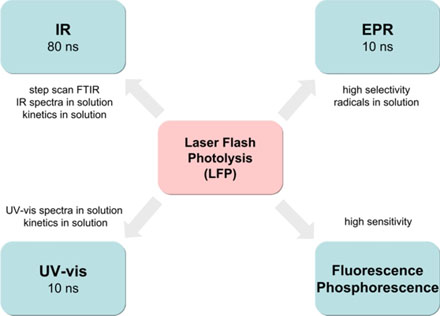Laser Flash Photolysis (lfp)
 The laser flash photolysis (LFP) is a useful method for the investigation of reactive intermediates generated by a laser pulse. The laser is installed orthogonally to the optical bank. For analysis purposes we use a pulsed Xenon-lamp whose focus lies within the flow cell, while the focus of the laser is found in front of this cell. The ray originating from the Xe-lamp can be interrupted by a shutter. The detector unit is composed of a manual monochromator and a photomultiplier which is connected to a computer via an oscilloscope.
The laser flash photolysis (LFP) is a useful method for the investigation of reactive intermediates generated by a laser pulse. The laser is installed orthogonally to the optical bank. For analysis purposes we use a pulsed Xenon-lamp whose focus lies within the flow cell, while the focus of the laser is found in front of this cell. The ray originating from the Xe-lamp can be interrupted by a shutter. The detector unit is composed of a manual monochromator and a photomultiplier which is connected to a computer via an oscilloscope.
The principle of LFP is based upon the measuring the optical density (OD, absorption) in dependence of time. In a certain time window 500 measure points are recorded; 50 of them lie before the laser pulse which generates the photo products. A tenth of this time interval (50 points) is called the time basis. After the pulse the OD has changed because of the different product composition now present in the flow cell.
When reactive intermediates are converted into further products with different velocities, LFP can be used to observe the process by the time-dependent increase or decrease of the optical density. A plot of OD (t)l vs. time (t) is called the trace of the transient. Transient spectra are obtained by a plot of the difference between OD before and after a single laser pulse ( D OD (l, t)) at a certain time (t) versus l. Normally a time window, instead of a fixed point in time, is the subject of observation. The D OD(l) is given by its average value over this time window in order to exclude the always occurring statistical noise. During the measurement of a transient spectrum it is possible to record several time windows simultaneously.
The lifetimes (t) of the transients are calculated by a computer program via first order kinetics.
The velocity-time-law (1st order) from A to P is
-d [A] / dt = k [A] an integration within the limits of [A]o to [A]t and to to t gives
ln ([A]o / [A]t) = -kt
[A]o = [A]t e-kt

